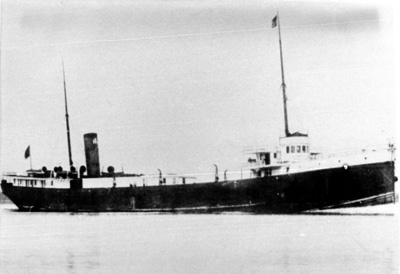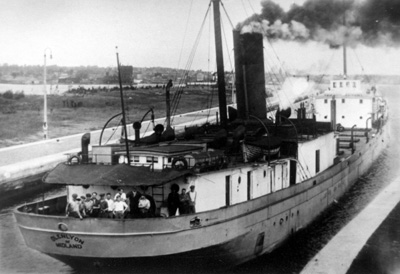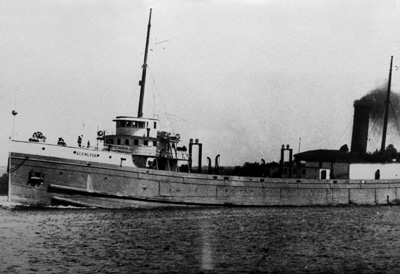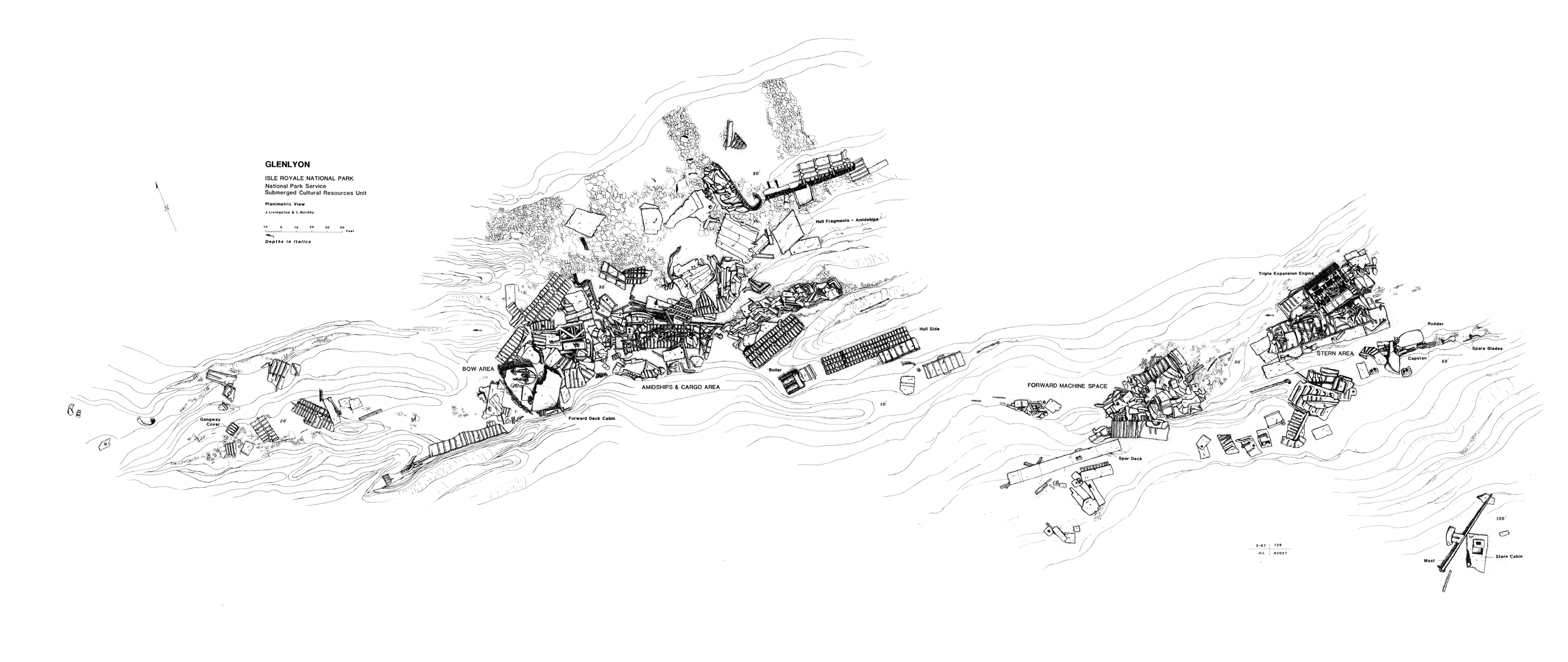Panoramic001.jpg)
SS Glenlyon
Quick Facts
William H. Gratwick, Minnekahta (1911)
1893
F.W. Wheeler & Company
F.W. Wheeler & Company
Triple Expansion Steam Engine
328 feet
2,759 tons
Chicago & Duluth Transportation Co.
Great Lakes Transit Company, Ltd.
William Taylor
143,000 bushels of wheat
Midland Shipbuilding Company
Great Lakes Transit Company, Ltd.
Unknown
U.S. 81427; later Canadian 126660
11/01/1924
Glenlyon Shoals off Menagerie Island
Minimum 15 feet; maximum 60 feet
0
84001750
G
LENLYON was built as WILLIAM H. GRATWICK in 1893 at West Bay City, Michigan by F.W. Wheeler & Company. The original U.S. registry number was 81427. Prior to 1893, Wheeler-built vessels carried engines built by one of two Detroit engine companies, S.F. Hodge & Company or the Frontier Iron Works. Wheeler later expanded its operations to include engine construction, and its own new engine works were put in operation in the latter part of 1892. The foreman of the new Wheeler facility was William Willis, formerly of the Hodge Company. Willis supervised the placement of the first Wheeler-built engine in hull 93. WILLIAM H. GRATWICK had the distinction of carrying their first engine (Wright 1969:124). The triple-expansion engine had cylinder diameters of 20, 32 and 54 inches on a 42-inch stroke, with an indicated horsepower of 1200. The original cylindrical Scotch boilers, 12 feet x 13 feet, were built by the Wickes Brothers Boiler Works of Saginaw, Michigan.
GRATWICK was built to serve as a package freighter for John Mitchell & Company of Cleveland. The hull was of steel with a length of 328 feet, a beam of 42.5 feet and a depth of 20.5 feet. Gross tonnage of the vessel was 2,818.27 and the net was 2,202.90. In the builder's certification of March 13, 1893, GRATWICK was described as a screw steamer with two decks, three masts, plain head, and round stern. GRATWICK was launched Saturday afternoon, February 4, 1893 (Port Huron Times Feb. 6, 1893).
The first owner of WILLIAM H. GRATWICK was the Mitchell Steamship Company of Cleveland (Doc, of Enrollment April 15, 1893, Huron, Ohio). The president of the company was Capt. John Mitchell, a prominent businessman, who was born in Canada in 1850.
Operational History

SS William H. Gratwick, 1893: Thom Holden Collection, ISRO Archives.
A change of ownership is recorded for GRATWICK in 1899. In October, the documents list the new owner as the Drake-Maythem Steamship Company of Mentor, Ohio (Duluth News Tribune Sept. 16, 1899; Doc, of Enrollment Oct. 16, 1899, Cleveland). This company retained ownership until 1902 when the ship was sold to the United States Transportation Company of Syracuse, New York (Doc, of Enrollment Oct. 14, 1902, Oswego).
GRATWICK was sold again in 1907 when the Prindville Transportation Company of Michigan City, Indiana became the owner (Doc, of Enrollment Nov. 29, 1907, Chicago). While owned by the Michigan City firm, GRATWICK was chartered by the Graham and Morton Transportation Company of St. Joseph, Michigan. The G&M Line operated ships in the fruit and passenger service from lower Michigan ports to Chicago but ran to Lake Superior ports for a few seasons (Detroit Marine Historian 1951, Vol. 4, No. 10:3). If GRATWICK carried the G&M colors at this time, she had a dark green hull and a black stack during this period.
The Chicago and Duluth Transportation Company of Michigan City purchased GRATWICK in 1910 (Doc, of Enrollment April 8, 1910, Chicago). While owned by this company, GRATWICK was noted for receiving the first load of iron ore taken from the Cuyuna Range in Minnesota.
In August 1911, the company changed GRATWICK's name to MINNEKAHTA (Doc, of Enrollment Aug. 23, 1911, Chicago). Apparently, the company converted both MINNEKAHTA and MINNETONKA, ex-ALVA, into passenger/package boats (Lake Carrier's Association 1924:119).
A "Coasting and Foreign Trade" document was issued in Chicago for the vessel in February, 1913. MINNEKAHTA was sold to the Lake Michigan Steamship Company of Gary, Indiana in September 1913 (Doc, of Enrollment Sept. 23, 1913). This company owned MINNEKAHTA for less than a year before reselling it. The ship's documents were surrendered in April 1914 when she was "sold foreign" to the Great Lakes Transportation Company, Ltd. of Midland, Ontario, who returned the ship to the grain and coal trades. MINNEKAHTA received Canadian registry number 126660.

SS Glenlyon: Historic Photograph Collection, ISRO Archives.
Four years later, the ship was overhauled at the Midland Shipbuilding Company, and renamed GLENLYON. Among the alterations were a steel deck house with accommodations for the master and mate added forward, another steel deck house built aft, and some minor repairs were made to the hull (Canadian Railway and Marine World 1918:126). At this time the ship had a light blue-gray hull, white cabins and a rose-red stack with a black top (Williams 1956:255). At the time, GLENLYON was one of a dozen vessels owned by this company, all the names of which began with "GLEN." (e.g. GLENFINNAN; GLENLEDIE).
GLENLYON had a rather unusual operational history. During the course of its serviceable life, the ship participated in the package freight trade, the passenger-package freight trade and the bulk grain trade in two countries. Few ships were involved in all the major trades of the Great Lakes.
GLENLYON was slightly damaged in an incident that occurred in August of 1920. While entering Sarnia, GLENLYON was diverted from its course by the schooner HATTIE HUTT and a sand sucker working at the port. GLENLYON lost steerage and struck the Grand Trunk Railway freight sheds causing $5,000 worth of damage (Canadian Railway and Marine World 1920:463).
Wreck Event

SS Glenlyon: Soo Young Collection, ISRO Archives.
The last navigation season for GLENLYON was 1924. On the last trip, the boat left Ft William, Ontario on Thursday, October 30 downbound to Port Colborne (Port Arthur News Chronicle Nov. 1, 1924) with a cargo of 145,000 bushels of wheat (Port Arthur News Chronicle Nov. 3, 1924). (The Superior Evening Telegram Nov. 1, 1924 reported 245,000 bushels; the Port Arthur News Chronicle Nov. 4, 1924 reported 318,000 bushels.) The last 3 or 4 weeks of the season were very stormy and foggy with gales and snowstorms. Ships in many ports were delayed while seeking shelter from winds and seas (Canadian Railway and Marine World 1925:642). GLENLYON was one of the vessels delayed. The boat cleared feet William Thursday night only to remain at anchor in the shelter of the Welcome Islands all of Friday, October 31 (Superior Evening Telegram Nov. 4, 1924) while a northeast gale raged (Port Arthur News Chronicle Nov. 1, 1924). The captain was William Taylor, it was his first season as master of GLENLYON. The chief engineer was Edward Hurl (Great Lakes Redbook 1924:72).
The weather lessened somewhat by Friday afternoon and Capt. Taylor resumed the voyage. The weather worsened, and the wind shifted to the north, then to the southwest, soon reaching a heavy gale ( Port Arthur News Chronicle Nov. 1, 1924). Shortly after clearing Passage Island, the course was altered to run down the south shore of Isle Royale to Siskiwit Bay to seek shelter from the storm (Canadian Railway and Marine World 1924:642). The storm of Friday night and Saturday would be labeled by mariners as one of the worst encountered in years. "Whitefish Light, which stands up some 60 feet out of the water, was deluged by the breaking waves, running mountains high" (Port Arthur News Chronicle Nov 3, 1924). John Collins, wireless operator off G.J. GRAMMER, a vessel crossing Lake Superior Friday and Saturday, made the following comments:
"Rough, I should say it was rough. The waves in Lake Superior on Friday last were mountains high. We had to ballast the boat with water to keep her on some sort of even keel. After a short lull Friday afternoon the wind at midnight reached the hurricane velocity of nearly 60 miles per hour. It came from the southeast to southwest. Our boat was tossing about like a cockle shell. Many of the crew had never been through such an experience before. I never want to go through it again (Port Arthur News Chronicle Nov. 4, 1924)."
At about LOO a.m. on November 1, (Houghton Mining Gazette Nov. 2, 1924) GLENLYON reached the entrance of Siskiwit Bay. While entering, the vessel ran hard aground on a submerged reef off Menagerie Island.
The first reports of the disaster were received by wireless in time to be carried in the November 1, 1924, edition of the Port Arthur News Chronicle. The account of the wreck that follows is taken from that source, except where otherwise noted.
Mate John McLaughlin and Watchman Wilfred Roy
Shortly after the wreck, two men set out in one of the ship's open lifeboats (referred to as a yawl in some reports). Mate John McLaughlin (reported as Daniel Mclaughlin, Daily Mining Gazette Nov. 4, 1924 and as Donald in Superior Evening Telegram Nov. 3, 1924) and Watchman (or wheelsman as reported in Detroit Free Press Nov. 2, 1924) Wilfred Roy were soon missing and were presumed lost in the first reports to reach Port Arthur. A search for the two men was begun.
It is not known why these two men left the ship. The reasons for their departure has been the subject of some speculation. One source (Wolff 1979:127) stated they launched the lifeboat to seek help. Another account asserted the two crew members launched the boat in a panic against the direct orders of the captain and were blown across the Lake to the Apostle Islands (Stonehouse 1974:9). In his next edition the latter author said the two men lowered the lifeboat in the confusion of stranding (Stonehouse 1977:51). Stonehouse may have confused the account of three sailors from GLENLOCHIE, who were drowned when their lifeboat was crushed against the side of their vessel after it was grounded in Lake Ontario. These men launched the lifeboat against their captains orders (Detroit Free Press Nov. 18, 1924). It seems most likely that the two men from GLENLYON were sent overboard to carry out a damage inspection and were accidentally swept away. No historical accounts have been located that shed any light on this event of the wreck.
At midnight on Saturday, November 1, the Canal Coast Guard crew arrived at Siskiwit Bay. A light was spotted on shore and the crew investigated. They found McLaughlin and Roy, the two men who had disappeared in a lifeboat. They had been washed ashore further up in Siskiwit Bay (Daily Mining Gazette Nov. 4, 1924). An earlier account said the men were picked up on the open Lake (Port Arthur News Chronicle Nov. 3, 1924). It is assumed the November 4 report is the accurate account. The two men were transferred to GLENNSANNOX with the rest of the shipwrecked crew. GLENNSSANOX soon left the site and headed east (Port Arthur News Chronicle Nov. 3, 1924).
As soon as GLENLYON struck the submerged reef, all crew members were ordered to their watch stations and the pumps were manned. The pumps were later abandoned, and the captain scuttled the ship to secure it to the reef (Canadian Railway and Marine World Dec. 1924). (It is is interesting to note that the captain scuttled the vessel to secure it but did not drop the anchors-they were found still shipped during the site investigations of 1982-84.) During the night GLENLYON communicated with the government wireless station at Port Arthur. John Bell, agent for the Great Lakes Transportation Company, was notified and dispatched the salvage tug STRATHMORE to the scene at 6:00 that morning. Agent Bell and Strathmore were familiar with shipwrecks at Isle Royale-they were both involved in the events of the wreck of MONARCH in 1906.
At 10:30 a.m. Saturday the steam tug JAMES WHALEN and barges EMPIRE and GREEN RIVER were dispatched to the site. By noon they had not reached the Welcome Islands because of the heavy weather that impeded the progress of the tug and its two tows. The Great Lakes Transportation Company indicated that it would also send the barge STRATHBUOY to the wreck as soon as tug STRATHMORE returned. The plan was to pump out and refloat GLENLYON after she had been lightered of its cargo. The grain was to be removed by EMPIRE, which was equipped with two clams, and then loaded onto GREEN RIVER.
STRATHMORE reached the wreck site about 1:00 Saturday afternoon. By 2:00 p.m. Agent Bell was able to report that he had received radio communication from Capt. Brown of GLENNLINNIE. Brown was able to pull alongside GLENLYON, remove the crew and transfer them to GLENNSANNOX.
Shipwreck Site Map
The ship broke in half, and parts of the stern are all that remain. Wreckage is widely scattered with no major sections intact. Bow section not yet located. Buoy on a sinker in 50 feet.

Hover
SS Glenlyon Site Map, Submerged Cultural Resource Unit, J.L. Livingston & J. Nerdby, February 1987, ISRO Archives.
Citations:
- Isle Royale Shipwrecks. December 15, 1965. Isle Royale National Park Archives, Resource Management Records: Branch Chief Era, CRM History (ACC#ISRO-00614, Box 117), Houghton, MI.
- Lenihan, Daniel. Submerged Cultural Resources Study. Santa Fe, N.M: Submerged Cultural Resources Unit, National Park Service, 1987. Print.